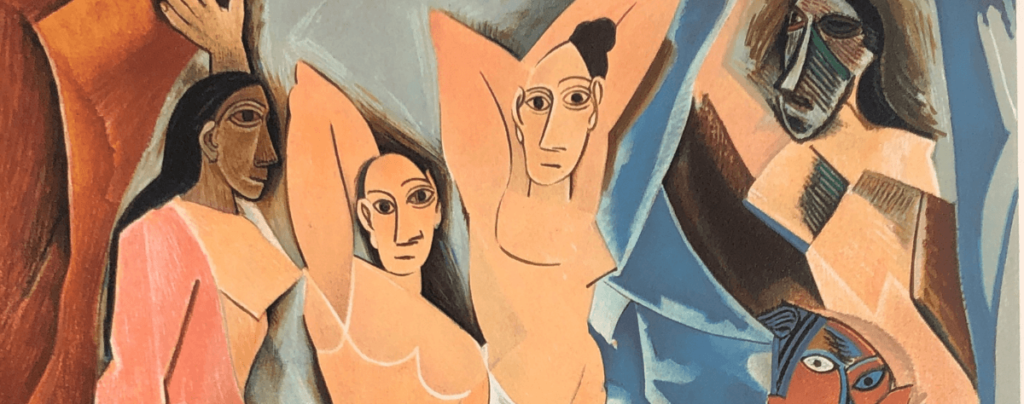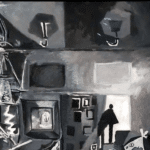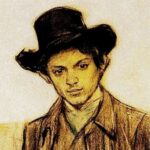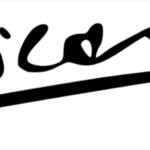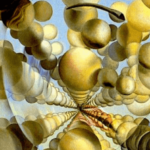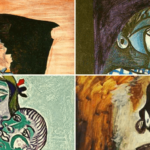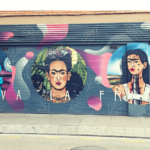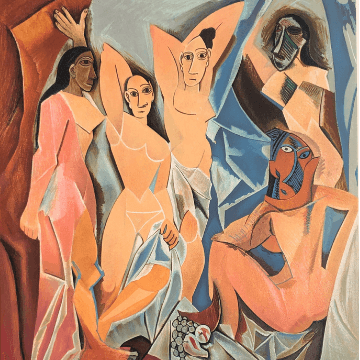
The Women of Picasso: Picasso Love Life
ALL THE PABLO PICASSO WOMEN
Picasso wouldn’t be Picasso without all of his women. A huge part of his work revolves around women, specially the ones he had love relationships with. But the way he treated them was often abusive. He’d be attracted by their youth, their beauty and talent, suck it off, then brutally substitute them by a new acquisition when they couldn’t offer him anything else.
Maybe he learnt such misogynistic behavior from his father, who introduced him to the Barcelona brothels when he was just 13 years old to make him “a man”. And he continued visiting them: his famous painting the Demoiselles d’Avignon actually represents the women that worked in a brothel in Avinyó street in Barcelona.
The truth is that he had a very low concept of females and said sentences such as:
“There are only two kinds of women: goddesses and doormats”
“Women are machines for suffering”
“Each time I leave a woman, I should burn her. Destroy the woman, destroy the past she represents”.
He indeed destroyed many of them. Only a few were strong enough to survive their relationship successfully. To see themselves first idolized in Picasso’s paintings, then savagely decomposed when another mistress entered his life.
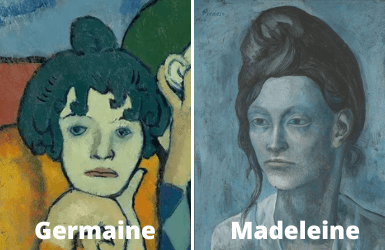
But who where the women of Picasso? Where did they come from, what role they played in the artist life? What happened to them after? Let me introduce you to Pablo Picasso women. Or at least, the ones that made history: there were many others that visited his bed and had sex with him anonymously and will remain forgotten.
Picasso Love Life
1
Young loves
Little is known about Picasso love life before his first great love. But there’s two names that appear in the records… after some digging:
Laure Germaine Gargallo Pichot (1880-1948)
She was a French dancer and model, and Picasso’s best friend Carles Casagemas was obsessed with her. Not being loved back, Casagemas killed himself in 1901. Just three months later, Picasso and Germaine started a relationship that lasted a few months until in 1902 she quitted him for the artist Ramon Pichot, who she’d end up marrying.
Madeleine
Not even the last name or age of this woman is known. She was a model and was the mistress of Picasso during the Summer of 1904. She got pregnant but had an abortion, leading to Picasso painting a series of maternities that distil the sadness of what could have been. She appears in several of his works: Woman in chemise, Madeleine crouching, Woman with a Helmet of Hair, Portrait of Madeleine and Mother and Child.
2
Fernande Olivier (1881-1966)
Relationship years: 1904 - 1911 (7 years)
Age gap: Pablo Picasso and Fernande Olivier where the same age when they met: 23 years old.
Her life before Picasso: The illegitimate child of the mistress of a married man, she was raised by an abusive aunt. To escape an arranged marriage, she ended up marrying another abusive man, that she eventually left without a formal divorce. To avoid being found, she changed her name and moved to Paris, where she started modelling for artists.
Her relationship with Picasso: They met in the Bateau Lavoir in Montmartre, Paris, where both lived. It was a stormy night and Picasso blocked her way on the stairs holding a kiddy cat. They were soon living together, and they often smoke opium and had jealousy fights: neither of them was faithful.
Picasso was so possessive that some times he’d lock her in their studio when he was going out. In 1907 she adopted a 13yo girl, but she had to send her back to the orphanage after discovering drawings of her naked made by Picasso.
Fernande in Picasso’s art: She’s said to have played an important role into getting him out of the depressive Blue Period and evolve into the Pink Period, and she was with him during the beginning of the Cubism, when her acquittances will often give her their condolences for her “mental boyfriend”. Head of a Woman (1909), considered the first cubist sculpture, is her portrait.
Her life after Picasso: After they separated, Fernande Olivier always struggled with money, having to work in odd jobs. Twenty years after they broke up, Picasso was already famous and she wrote her memoir, Picasso et ses amis, published in 1930 as a series in a Belgium newspaper.
Picasso paid her to stop it, but the money didn’t last her much. In 1956 she was poor, deaf and arthritic and she asked Picasso to pay her a small pension with the promise that she wouldn’t publish anything else until they both died. It was his godson who finally published them in 1988 as Souvenirs Intimes.
3
Eva Gouel (1885-1915)
Relationship years: 1912 - 1915 (3 years)
Age gap: Pablo Picasso was only 4 years older than Eva Gouel. They were 31 and 27 when they met.
Her life before Picasso: She was a French woman that like many other in the Parisian Belle Epoque loved to keep her background mysterious. Maybe because of that she changed her name to Marcelle Humbert at some point. We just know that she was in a relationship with a Polish artist when she met Picasso.
Her relationship with Picasso: Fernande Olivier and Marcelle were friends, and Fernande confided on Marcelle about the difficulties of his relationship with Picasso. In an occasion, she asked her to cover her up so she could meet an Italian artists she was having an affair with. But instead, Marcelle took the opportunity to start her own affair with Picasso instead.
Picasso asked her to recover her original name, but translated to Spanish: Eva sounded more sensual and reminded him of Eve, the first biblical woman. In 1913 they escaped to the South of France, trying to avoid Fernande. They also visited Picasso’s parents in Barcelona (Spain) and talked about marriage. Unfortunately she contracted tuberculosis that same year, and passed away in 1915 after weeks in hospital.
Eva in Picasso’s art: She’s Picassos muse of Cubism, and appears in “Seated Woman Wearing a Hat Trimmed with a White Bird”, “Woman in an Armchair”, “Eva on her Deathbed”, and is Picasso’s “pretty one” in “Ma Jolie”.
4
Short relationships
Gabrielle Depeyre Lespinasse (1888-1970)
A singer and dancer who’s stage name was Gaby, la Catalane, she had a relationship with Picasso while Eva was already ill in 1915. Picasso was 34 and she was 27. At the time, she was dating the artist and poet Herbert Lespinsasse and had already taken his name even if they weren’t married yet.
They spent some time together over the Mediterranean coast while Eva was being treated in a nursing home. But when Pablo Picasso asked her to marry in 1916, she rejected him, and married Herbert Lespinasse instead the year after.
Paquêrette
Born Emilienne Geslot, she was an actress and haute-couture model for several Parisian artists including Picasso. She was 20 and Picasso 35 when they dated for at least 6 months in 1916.
Irène Lagut (1893-1994)
Friend of Apollinaire, who hung out with Picasso, it seems both would have “kidnapped” her into a villa in the suburbs of Paris. She escaped but returned a week later, seduced by Picasso’s charm. They were together in 1916 and Picasso proposed her, but she ran back to her previous lover the painter Serge Férat.
5
Olga Stepanovna Kokhlova (1891-1954)
Relationship years: 1917 - 1935 (18 years, but officially married until her death in 1954)
Age gap: Picasso was 10 years older. They were 36 and 26 when they met.
Her life before Picasso: She was a ballet dancer, member of the Ballets Russes troupe led by Sergei Diaghilev.
Her relationship with Picasso: Picasso and Olga met when Picasso designed the costumes and set of the ballet show Parade. She quitted the dance troupe to stay with Picasso and they went to Barcelona to meet his parents. When Picasso’s mother didn’t approve of him marrying a foreigner, he painted Olga dressed as a Spanish lady in the traditional dress.
Back to Paris, they married on July 12, 1918 by the Russian Orthodox rite. In 1921 they had a son, Paulo, and after that Picasso went back to flirting with other women and cheating. When Olga found out that Marie Thérèse Walter was pregnant with Picasso’s child she filed divorced but Picasso refused: he didn’t want to have to split his fortune and art collection with her.
Olga in Picasso’s art: She appears in Picasso’s life when Cubism is in full swing, but she doesn’t understand this kind of art and demands that her portraits are made in an academic style. There’s several of them: “Olga on an armchair” (1917), “Olga with mantilla shawl” (1917), “portrait of Olga Kokhlova” (1921), “Maternity”, “Dance” (1925)… After they break up, Picasso represents Olga as a horse gored by Picasso disguised as a minotaur or a bull: “The Minotauromachy” (1935), “Bullfight: Death of the Torero” (1935).
Her life after Picasso: Olga remained legally married to Pablo Ruiz Picasso until she died of cancer in 1955. Years earlier she had suffered a stroke and as a result of that she wasn’t able to walk again.
Doomed descendants: Their only son Paolo worked Picasso’s private driver, but the artist treated him with disdain. That led Paolo to suffer depression and become an alcoholic. He died because of his addition at the age of 54 years old. One of his three children, Pablito Picasso, committed suicide by drinking a bottle of bleach after Picassos’s widow Jacqueline banned most of the family from attending the artist’s funeral in 1973.
6
Marie Thérèse Walter (1909-1977)
Age gap: Picasso was 29 years older. He was 45 when he met her, and she was underage: just 17.
Children with Picasso: Maya (Maria de la Concepción)
Her life before Picasso: She was just a young inexperienced girl when Picasso approached her saying “You have an interesting face. I would like to create a portrait of you. I feel we are going to do great things together. I am Picasso.” To his surprise, she had never heard of him, so he took her to a bookstore to show her a book about him.
Her relationship with Picasso: She was obedient, passive and innocent, at the same time that sensual and voluptuous, and Picasso was able to manipulate her at will. She moved close to Picasso’s house, while their relationship was kept in secret. In 1935, Marie Thérèse got pregnant and his still official wife Olga heard about it and decided to separate from him.
When their daughter Maya (Maria de la Concepción in Spanish) was born, the couple moved to the South of France, and later Marie Thérèse and Maya went near Versailles, where Picasso visited them in the weekends. By then Picasso was already dating Dora Maar, and there were outbursts of jalousie between the two women.
Marie Thérèse in Picasso’s art: She was the muse of Picasso’s surrealism, always featured with gentle round shapes and bright colors. She appears in many paintings, such as Sleeping Nude (1932), Le Rêve (1932), the Suite Vollard, Portrait of Marie Thérèse Walter with Garland (1937)… When the relationship is coming to an end, she also shows as a tortured woman in Femme en Pleurs. Picasso’s most expensive portrait sold to-date is one of her portraits: Nude, Green Leaves and Bust.
Her life after Picasso: With the beginning of World War II, Marie Thérèse and Maya moved back to Paris and they received economical support from Picasso. 4 years after Picasso’s death, she killed herself. One of their 3 grandsons, Olivier Widmaier Picasso, published a biography of the artist called Picasso: The Real Family Story.
7
Dora Maar (1907-1997)
Relationship years: 1935 - 1945 (10 years)
Age gap: 28 years. They met when Picasso was 54 and Dora was 28 years old.
Her life before Picasso: His father was from Croatia, her mother from France, and she was raised up in Argentina, where she learnt Spanish – which was also Picasso’s mother tong. She was a talented photographer, poet and painter. She studied photographie with Henri Cartier-Bresson, Brassai and Man Ray.
Her relationship with Picasso: They met in a café where Dora was playing to stab a knife between her fingers on a wooden table, and Picasso asked her to gift him her blood-stained gloves. Dora’s parents strongly opposed to their relationship, up to the point that her mother died of a stroke during a heated discussion they were having over the phone about it.
Dora was stubborn and brilliant, a very strong woman, and compared to Marie Thérèse she posed more emotional challenges to Picasso. When she discovered that the artist was having an affair with Françoise Gilot in 1945, she told him “As an artist you may be extraordinary, but morally speaking you are worthless”.
Dora in Picasso’s art: Dora Maar documented photographically Picasso’s process of painting the famous Guernika. Picasso found her emotionally unstable and difficult, and that shows in the portraits he made of her as a tortured woman. An example is the famous “Weeping Woman” (1937). She didn’t like them and always stated that “All portraits of me are lies. They’re Picassos. Not one is Dora Maar”.
Her life after Picasso: After breaking up, she suffered of depression and she was interned in a mental hospital, where she was was treated with electroshocks (forbidden at that time). The poet Paul Éluard, good friend of Dora, demanded Picasso to remove her from the hospital and accused him of making her suffer.
Picasso bought her a house in the South of France and she retired there alone. That’s where she embraced Catholicism and started painting abstract pieces (as opposed to the cubism that Picasso had always forced her into). She spent her last years back in Paris, impoverished and recluse.
8
Françoise Gilot (1921-2023)
Age gap: 40 years. Françoise was just 23 years old when she met a 62 years old Pablo Picasso.
Her life before Picasso: Daughter of a business man and a watercolor artist, Françoise dropped her law studies to pursue her passion for art. She had already had her first exhibition in Paris the year he met Picasso.
Her relationship with Picasso: Despite her youth, Françoise Gilot was strong-willed and self-confident, and refused to play the role of vulnerable lover. After he quitted Dora, they moved together in 1946, and their first son Claude was born the year after. Paloma was born in 1949. She left Picasso after he had an affair with Genevieve Laporte (aged 24) in 1953.
Françoise in Picasso’s art: She appears in the painting Joie de Vivre as a Woman-Flower (“femme-fleur”).
Her life after Picasso: Pablo Picasso might have been one of the reasons why Françoise Gilot’s artistic career never took off: when she left him, he told the art dealers he knew to not buy her art. And of course, people saw her more as Picasso’s ex-lover than as an individual artist. In 1955 she married the artist Luc Simon and had a daughter with him. They divorced in 1962.
In 1964 she wrote the book “Life with Picasso), that sold milions of copies. Picasso was so mad that he refused to ever see her children anymore. Nevertheless, the sales of the book provided money for her children to mount a case to become Picasso’s legal heirs (since Picasso was still legally married to Olga Koklova when they were born). In 1969 she met the polio vaccine creator Joans Salk, who she married in 1970. She lived her last years between NYC and Paris where she continued to exhibit her works internationally.
8
Jacqueline Roque (1927-1986)
Relationship years: 1953-1973 (20 years)
Age gap: 46 years. Jacqueline was 26 and Picasso was 72 when they first met.
Her life before Picasso: Her father abandoned her mother when she was just 2 years old, and her mom worked hard to raise her and her brother. When her mother passed away Jacqueline was only 18. She married an engineer and they moved to West Africa, where they had a daughter. But she divorced, went back to France and she started to work in the Madoura Pottery workshop where she met Picasso.
Her relationship with Picasso: Jacqueline resisted for six months the advances of Picasso, who brought her a red rose every day and did all kind of romantic tricks to convince her. But she was reluctant: she knew about Picasso’s reputation with women and she warned him that “If one day there is another muse, I’ll congratulate her, I’ll send her flowers. But I’ll be out the door”.
It worked because during the 20 years of their relationship until Picasso’s death he never painted another woman. They married in secret in Vallauris (South of France) in 1961. She became her most loyal assistant, keeping him free of unwanted visitors – which sometimes also included old friends and relatives.
Jacqueline in Picasso’s art: Jacqueline is represented in over 400 works of Picasso and there’s at least 70 portraits of her. She usually appears with an exaggerated neck and a Greek nose. She inspired his for his series about Delacroix’s Women of Algiers.
Her life after Picasso: She was such a fierce protector of Picasso’s privacy that she banned his children and a large part of the family from attending the funeral. As a result, Pablito, his grandson, committed suicide by drinking a bottle of bleach. That same night she slept over Picasso’s grave, in the snow.
In the next years she devoted herself to the creation of the Picasso Musée in Paris, born out of the dispute with Gilot’s children for their father inheritance. Then came depression and alcohol. Finally, feeling she had already done as much as she could for the love of her life, she killed herself by shooting in the castle where they have lived together. It was 1986, 13 years after Picasso’s death. She was buried next to Picasso in the Vauvenargues palace, per her request.
Whoe were the other women of Picassos' life?
Mother and sisters
Picasso’s mother was named María Picasso y López. And while it was his father who introduced him to the world of painting (he was an art teacher), Picasso took his mother’s last name as his stage name. His fathers last name Ruiz was too difficult to pronounce in France, and to common in Spain.
Picasso had two sisters. The youngest one, Conchita (a Spanish nickname for María de la Concepcion) died at age 7 from diphtheria. Picasso was just 13 years old. Who knows how much this early loss affected him.
His first daughter was called after her, although she was finally known as Maya because that’s how the child pronounced Maria. And could it be that Picasso was unconsciously looking for his lost little sister in the very young lovers he too?
His other sister was called Lola (María Dolores), an she is the subject of many of the early portraits painted by Picasso and until he settles down in Paris.
Gertrude Stein
When her brother moved to Italy, she kept the Picasso part, while he took Cezanne’s. And Gertrude continued to purchase Picasso’s cubist paintings – that Leo hadn’t appreciated.
She organized weekly gatherings that were attended by many Paris artists, including Picasso and his gang. In 1907 Stein introduced Picasso to her life partner, Alice B. Toklas, while he was painting his masterpiece Demoiselles d’Avignon. From them on, Stein was a first-line witness of Picasso’s relationships.
Should we judge Picasso for his art of for Picasso love life?
Marta
MORE BARCELONA TIPS FOR YOU:
SHARE WITH YOUR TRAVEL MATES
RESEARCHING FOR A TRIP IS TIME-CONSUMING…
Need more inspiration?
Our 100% FREE Barcelona Collection will give you everything you need to organize the trip of your lifetime to Barcelona.
BEST INSIDER TIPS FROM THE PROS!

Last update on 2024-04-19 / Affiliate links / Images from Amazon Product Advertising API

